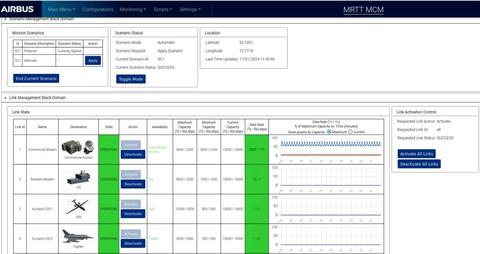Introduction
When resources are constrained on networks and communication links are impaired due to DDIL (Denied, Disrupted, Intermittent and Limited) environments, performances need to be optimised by reconfiguration of cross-layer parameters, breaking the boundaries across the traditional layers of the communications protocol stack.
Airbus’ MCM (Mission Communications Manager) interfaces to multiple layers of the protocol stack to achieve performance optimisation of applications over networked bearers.
The MCM has a powerful decision engine facilitating the prioritisation of mission critical information, adapting and coping with new and unforeseen contingencies. It is an application for defence environments where communications are at their most challenged, be that in fixed infrastructure or at the front line of the battlespace.

Plans are simple to configure and links can be easily interpreted and managed.

Link status and data usage are clearly presented.

MCM constantly monitors and controls multiple layers within the protocol stack to prioritise mission communications.
Enhances Denied, Disrupted, Intermittent and Limited (DDIL) communications
Rather than trying to answer the question “how do I get all this data from A to B with throughput X?”, instead think “how do I get the information I really need to where I need it and when I need it, adapting to unforeseen contingencies?”.
MCM is a multi-layer based flexible, reconfigurable management system. It addresses changing network topologies and varying information requirements at different phases of any mission. Data links are managed in foreseen and unforeseen communications scenarios typical of contested battlefields.
MCM introduces the concept of Quality of Experience (QoE) at the application layer to optimise the user experience in mobile environments.
This differs from standard traffic engineering prioritisation that is solely based on QoS Service Level Agreement performance (throughput, latency, jitter, packet losses) which often results in a sub-optimal user experience.
MCM influences multiple aspects of QoE:-
- System - manages connectivity and adherence to service level agreements
- Context - Configures communications for different mission scenarios
- Content - prioritises data from applications & services
- Perception - simplifies user interaction
Simplifies Complex Communications Environments
The MCM’s simple user interface provides performance, fault, configuration and status management for the complete communications environment.
A variety of communications links, networking and application layer equipment are supported.
Multi-level security exchange gateways and a ‘single pane of glass’ interface enables complete control of traffic in classified and unclassified security domains.
Automation within the MCM decision engine simplifies the complex process of selecting the optimum communications configuration for any given moment.
Expedites Mission Readiness
The use of mission plans with communications scenario templates greatly simplifies and expedites the configuration of communications on a terminal. Plans can be pre-configured or uploaded ‘on the fly’.
Equipment fault and alarm indications, coupled with the ability to view the status and performance at the data-link, network and application layers, allows for rapid troubleshooting and simplifies diagnostics at start-up.
Reduces Operator Cognitive Load
Defence networks are becoming increasingly complex through an ever increasing appetite for data, an expanding number of sensors and nodes and the faster pace of the battlespace.
The MCM aids over-burdened communications operators and users, decreasing decision time and risk.
In automatic mode the MCM manages communications in line with priorities and SLAs. Alternatively, in manual mode it provides decision support by suggesting optimal configurations.
The ability to rapidly pinpoint and correct performance issues is provided by the terminal alarm and fault reporting capability.
Plans from HQ can be uploaded and applied to platforms on the move further reducing the deployed operator’s load.
Contact us for more
Discover more news

Airbus launches multi domains 5G communication project


